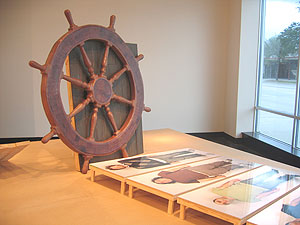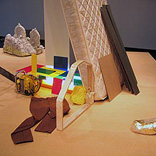It's a group show of sculpture by four guys on a really big, low table. The sculptures are nice, but first, let’s talk about the table. Like all truly paradigm-setting ideas, once you've seen it, it seems so obvious that someone must have done it before, but if so, I don't know who.
The big table solves many problems that plague floor sculpture. It incorporates Lawndale's obtrusive pillars into the piece. It allows the artists to control the floor surface their work is displayed against. Galleries all have nice walls, but few have nice floors, and even fewer are willing to change the flooring to suit the art. Think of the green terrazzo in the MFAH's Mies Van Der Rohe Building. The big table gets rid of pedestals, yet effectively prevents pieces being kicked, stepped on, or tripped over. It's a great idea. I'm going to use it myself.
Once you've swallowed the table, the next thing to do is unravel who made what, like it's big mystery. Based on what I saw of these artists’ work at the last Core show, I'm guessing Gilad Efrat made the painting of the lunar surface and Demetrius Oliver took the four photographs of the artists. Carl Suddath made the fantastic aluminum folding easel/modern sculpture. Michael McKean is the genius behind the platform itself, and the arrangement of Plexiglas, chainsaw, and the houseplant. The rest of the objects fall into loose confederations to which I'm unable to assign specific authorship. A painted wooden object like a pink table or offshore oil rig, another with an X on a platform, and the wooden frame next to the mattress have a family resemblance, as do the plaster, clay and paper-mache lumps. The ship's wheel, two handmade faux packing blankets, pants and fake boards all share a surreal, narrative bent. Maybe you could assign authorship to each object if you cared, but the piece functions well enough as a whole that assigning praise or blame for its ups and downs is not the first concern.
The objects are arranged in a tidy, aestheticized clutter with the studied spontaneity of Japanese gardens. No godawful mess, but no rigid program either. It's an elegant, artful, picturesque style of composition, which would annoy me if it were in a painting. But sculpture is less hag-ridden by history, and the composition reads as pleasant and unremarkable, like a shop window.
Two major clusters, one at each end of the platform, are connected by a picturesque zigzag. The clusters face in opposite directions, and echo one another: the leaning mattress and leaning wheel, both wedged up with lumps of clay and cement, the wood grained fake boards, cubist constructions. In the center, two empty packing blankets imply unfinished business, as if something else is being installed or removed.
Most of the objects are very tactile sculpturey-sculpture, with a range of vividly contrasting materials, textures, forms and colors, which tends to leave the photographs and the painting out in the cold. The painting is physically distanced from the rest of the piece anyway, like the moon over a landscape. The four full-length photos of the artists spread like specimens against neutral white backdrops make a stab at going along with the program by being mounted on tilted wooden tables, but they don't fit. It's not just technique; the self-conscious pop-eyed oddness of their expressions gives them the slap-happiness of a yearbook gag photo, and is quite different from the mute formal elegance of the rest of the show.
The overriding, relentless sound element could be either energetic sawing or sex on a squeaky bedspring. Interpreted as sawing, it's comical overstatement. There are sawn boards everywhere. Then it suddenly it flips, and becomes embarrassing voyeurism. The mattress, cast-off pants and phallic chainsaw suddenly make sense. It’s rhythmic, however you want to interpret it, and gives the piece a busy-beaver eagerness, like either a collaborative science-fair project or a gang-bang.
Overall it's OK. There are some bright spots, like the aluminum scaffold and the pants, a few bits which would seem lame if they had to stand alone, like the pink table, and, inevitably, a fair amount of filler. Mixed together it all cancels out, leaving the display concept the strongest statement in the show. Artistic inspiration , at least in this case, isn't additive.
Images courtesy Lawndale Art Center
Bill Davenport is an artist and writer living in Houston. He was one of the first contributors to Glasstire.





